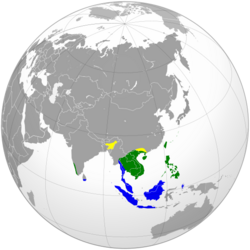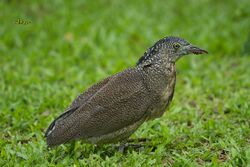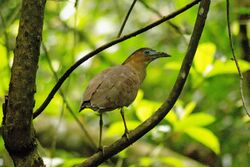Biology:Malayan night heron
| Malayan night heron | |
|---|---|

| |
| Scientific classification | |
| Domain: | Eukaryota |
| Kingdom: | Animalia |
| Phylum: | Chordata |
| Class: | Aves |
| Order: | Pelecaniformes |
| Family: | Ardeidae |
| Genus: | Gorsachius |
| Species: | G. melanolophus
|
| Binomial name | |
| Gorsachius melanolophus (Raffles, 1822)
| |

| |
| Range of G. melanolophus Breeding range Resident range Wintering range
| |
The Malayan night heron (Gorsachius melanolophus), also known as Malaysian night heron and tiger bittern,[2] is a medium-sized heron. It is distributed in southern and eastern Asia.
Distribution and habitat
The Malayan night heron has been found in India , Sri Lanka, Brunei, Nepal, Bangladesh, Myanmar, Cambodia, Laos, Vietnam, Thailand, Malaysia, Singapore, China , Indonesia, the Philippines , Taiwan and Japan . It is a vagrant in Christmas Island and Palau.[1] Its range size is estimated at 1,240,000 km2.[1] This bird occurs in forests, streams, and marshes.[3]
Description
The Malayan night heron is about 48 cm (19 in) long.[4] The wingspan is about 86 cm (34 in).[5] It is stocky, with a short beak. Its neck and breast are rufous. There are streaks going down the centre of the neck to the breast.[4] The upperparts are chestnut and vermiculated. The flight feathers are blackish.[4] The crown is black, the chin is white, and the eyes are yellow.[6] The beak is black and the legs are greenish.[5] The juvenile is greyish to rufous and is spotted and vermiculated.[3]
Biology
The Malayan night heron is usually solitary. It roosts in trees and feeds in open areas.[4] Its territorial call is deep oo notes.[4] It also produces hoarse croaks and arh, arh, arh.[6] The most common food items are earthworms and frogs, and it will sometimes eat fish.[7] A study of its pellets found reptiles, snails, chilopods, arachnids, crabs and insects.[8]
Conservation
The bird has a large range and its global population is between 2,000 and 20,000 individuals. Its population trend is not known, but it does not meet the criteria for a vulnerable species status.[1]
References
- ↑ 1.0 1.1 1.2 1.3 BirdLife International (2016). "Gorsachius melanolophus". IUCN Red List of Threatened Species 2016: e.T22697242A93604480. doi:10.2305/IUCN.UK.2016-3.RLTS.T22697242A93604480.en. https://www.iucnredlist.org/species/22697242/93604480. Retrieved 12 November 2021.
- ↑ "Malayan Night-Heron". http://www.birdingintaiwan.com/malayannightheron.htm.
- ↑ 3.0 3.1 Grimmett, Richard; Inskipp, Carol; Inskipp, Tim (2013). Birds of the Indian Subcontinent. Bloomsbury. p. 82. ISBN 978-1-4081-6264-4. https://books.google.com/books?id=kMwXBAAAQBAJ&pg=PA82.
- ↑ 4.0 4.1 4.2 4.3 4.4 Jeyarajasingam, Allen; Pearson, Alan (2012). A Field Guide to the Birds of Peninsular Malaysia and Singapore. Oxford University Press. p. 99. ISBN 978-0-1996-3942-7. https://books.google.com/books?id=XCwUDAAAQBAJ&pg=PA99.
- ↑ 5.0 5.1 Kennedy, Robert (2000). A Guide to the Birds of the Philippines. Oxford University Press. p. 31. ISBN 978-0-1985-4668-9. https://books.google.com/books?id=fPDxk551AhkC&pg=PA31.
- ↑ 6.0 6.1 MacKinnon, John; Phillipps, Karen (2000). A Field Guide to the Birds of China. Oxford University Press. p. 236. ISBN 978-0-1985-4940-6. https://archive.org/details/fieldguidetobird00john.
- ↑ Chang, C. (2000). Malayan Night Heron Gorsachius melanolophus breeding in immature plumage. Forktail 16 167–8. Downloaded on 26 August 2010.
- ↑ Kawakami, Kazuto; Fujita, Masaki; Hasegawa, Motohiro; Makahira, Hiroshi (2011). "Dietary characteristics of the Malayan Night Heron (Gorsachius melanolophus) in the Yaeyama Islands, southern Japan". Chinese Birds 2 (2): 87–93. doi:10.5122/cbirds.2011.0015. http://www.chinesebirds.net/EN/abstract/abstract75.shtml.
External links
Wikidata ☰ Q764171 entry
 |





